Plant Biology Exam 2- Tom Holder
1/99
Earn XP
Description and Tags
Energy & the Molecules of Life
Name | Mastery | Learn | Test | Matching | Spaced |
|---|
No study sessions yet.
100 Terms
Energy
-ability to do work (move matter against a force or catalyze change)
-no mass and does not occupy space
Kinetic Energy
requires lots of energy
-action
-applying force
Potential Energy
requires small amount of energy
-stored energy
-available to do work/action
ex: ATP, stored energy in glucose, sunlight energy…
Laws of Thermodynamics are?
Energy transformations
How many laws of thermodynamics are there?
2
the first law:
Energy can be neither created nor destroyed.
-in any process the total amount of energy in a system remains constant.
the 2nd law:
No energy transformation is 100% efficient.
-systems tend toward disorder, and some energy always will be converted to heat.
the 2 thermodynamic laws can be applied to what?
a food web
Energy transfers
they decrease/lower the bigger the animal.
-heat energy is removed every time.
-birds and mammals have more energy b/c they hold heat energy, but less energy %.
-transfers will run out of available energy in the end.
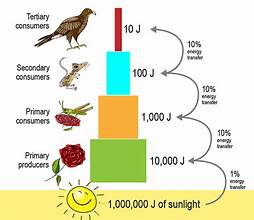
Energy Metabolism
Photosynthesis: uphill rxn
cellular respiration: downhill rxn
-energy transformation and production.
-ATP energy released and rest of the energy is released as heat.
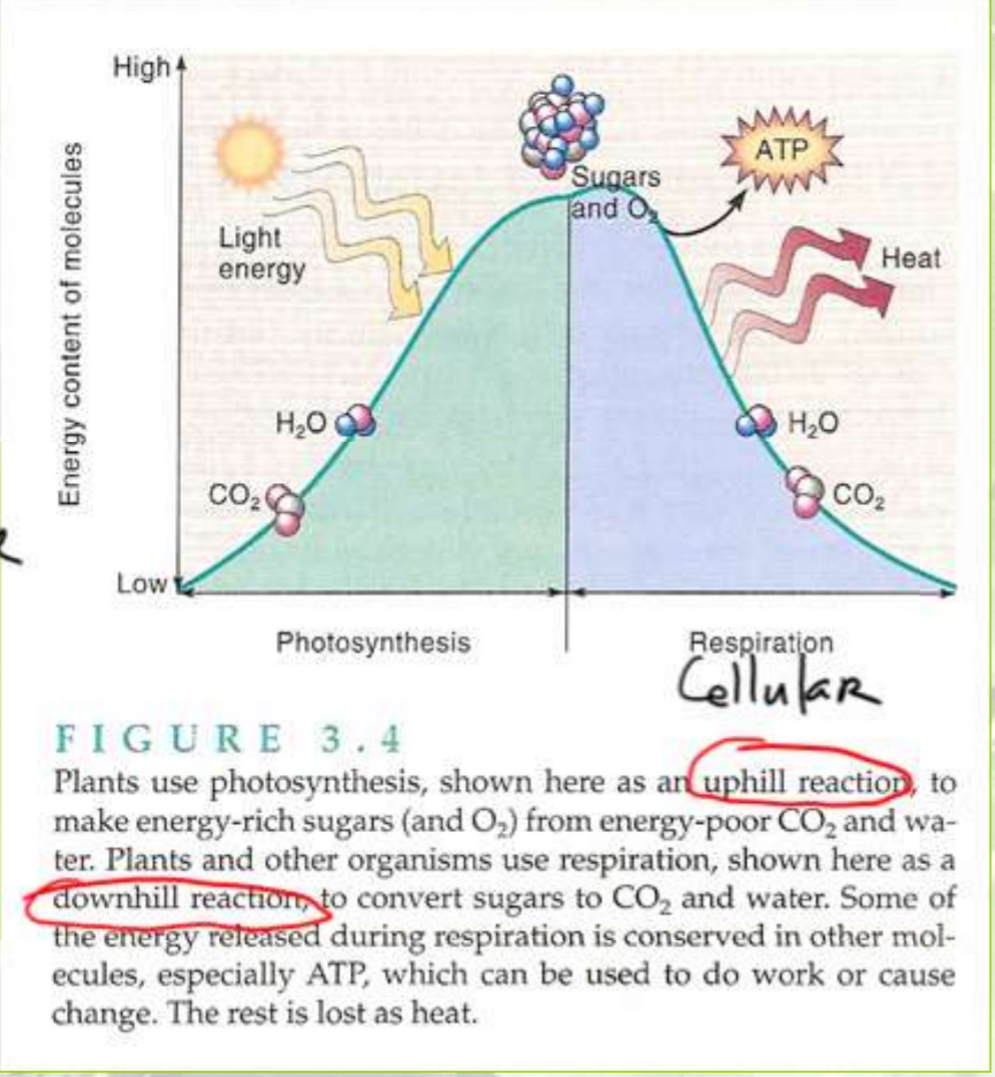
Oxidation and Reduction
-the occur simultaneously
-oxidized: donates electrons.
-reduced: accepts electrons.
Lose Electron Oxidation, Gain Electrons Reduction.
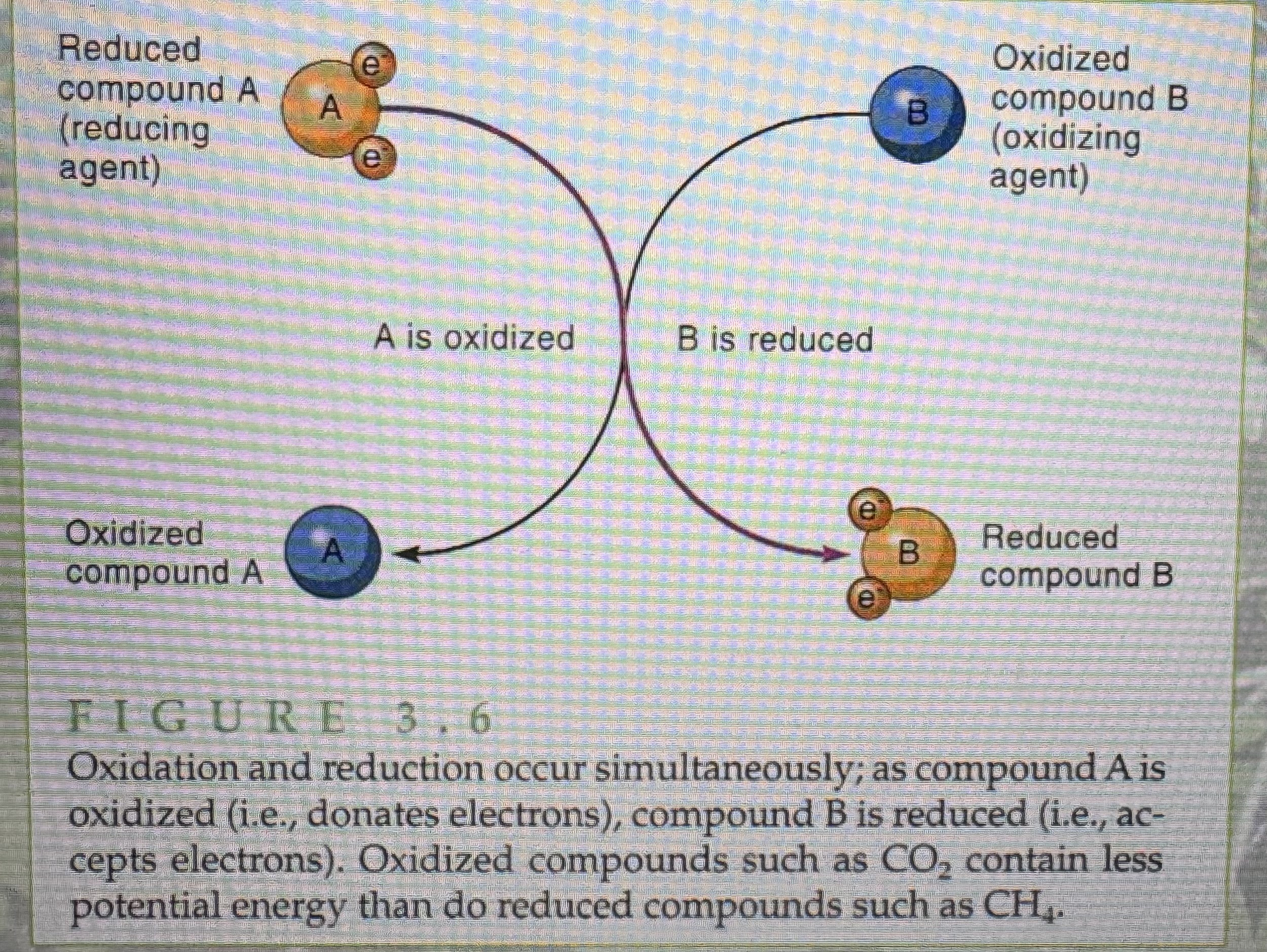
CH2O + O2 —> CO2 + H2O + heat
CH2O to CO2 is the oxidation
O2 to H2O is reduction
Equation for cellular respiration
CH2O + O2 —> CO2 + H2O + heat
Equation for photosynthesis
CO2 + H2O + heat —> CH2O + O2
How do organisms go about facilitating these reactions?
ENZYMES
What are enzymes?
-special proteins.
-speed up rxns with out being consumed by lowering the “energy of activation”.
-all enzymes are special proteins, but not all proteins are enzymes.
What do enzymes allow to occur at biological temp. ?
chemical reactions
Enzymes are
accurate and precise breakdowns!!
With an enzyme distance/energy is
shorter and less.
-more efficient conversion
Enzymes catalyze reactions
-substances with increase at the rate of a reaction without being used up themselves.
-enzymes are like the matchmakers of the chemical worlds.
-”fit” for a specific substrate which it reacts with.
Macromolecules (biomolecules)
carbohydrates
lipids
proteins
nucleic acids
monomer vs polymer
key point of life: larger objects are made up of smaller objects.
monomer: single molecules
polymer: group of monomers bonded together.
Carbohydrates
-sugars
-function: store and supply energy
-monosaccharide: glucose (simple sugar)
-disaccharide: sucrose (double sugar)
-polysaccharide: starch and cellulose (long sugars)
starch and cellulose
starch: stores energy
cellulose: cell wall structure
Proteins
-function: catalyze reactions (enzymes) and are structural building blocks.
-they are polymers of amino acids. (AA chain form proteins)
-2nd most common type of organic molecule in plants.
Nucleic Acids
function: codes and expresses genetic information
-DNA and RNA: polymers of nucleic acids
-these are mostly found in nucleus of cells
-chains of nucleotides.
DNA and RNA
DNA twists into a double helix
RNA is a single strand
Lipids
-fats, steroids, waxes.
-function: cell membrane components, energy storage
-made up of mostly Carbon (C) and Hydrogen (H).
Photosynthesis and Cellular Respiration
P: in plant only
CR: in all
both occur in plants though
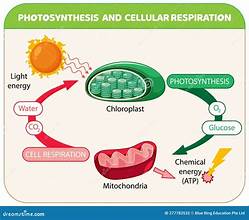
Photosynthesis
-captures sunlight and stores it in a raw form (glucose, C6H12O6)
-stored energy in chemical bonds.
-biological energy
Cellular Respiration
-take the raw form and converts it into something useful (ATP)
-chemical bonds to ATP
-biological energy
P vs CR in diagram
P: build glucose from light, water, CO2
-uphill
CR: burn glucose to yield ATP
-downhill
only green plants and some algae can use ____ to create their own energy in the form of sugars
photosynthesis
all organisms (including plants) use ____ to unlock the energy stored in sugars. the energy created is called ____.
cellular respiration; ATP
ATP is the
biological energy molecule
What type of reaction is photosynthesis?
endergonic
endergonic reaction
-requires more energy
-input energy comes from sunlight.
-energy is captured by photosynthetic pigments within chloroplasts.
-uphill
what type of reaction is cellular respiration?
exergonic reaction
exergonic reaction
-releases energy
-stored energy from photosynthesis is released (downhill) to produce useable chemical energy (ATP) to do work.
Photosynthesis inputs and outputs
inputs: water, carbon dioxide, sunlight
outputs: sugars and oxygen
Cellular Respiration inputs and outputs
inputs: oxygen and sugar
outputs: carbon dioxide, ATP (energy) and water
Key points of cellular respiration
-occurs in the cytoplasm and mitochondria
-breaks apart glucose to use stored energy
-can use oxygen
-all organism undergo this
-how animals get energy from the food they eat
-how plants unlock energy stored in
the sugars the make
the 4 main stages of cellular respiration
glycolysis (in cytoplasm)
formation of Acetyl Coa (in mito.)
the krebs cycle (in mito.)
the electron transport chain (in mito.)
goal: to take stored energy from photosynthesis and make useable energy (ATP)
Step 1: Glycolysis
-glucose is split (energy is stored in chemical bonds)
-glucose: C6H12O6
-splits sugars
-glyco: sugar
-lysis: splitting
Glycolysis: Process Simplified
input energy (ATP) to change sugar chemistry
-if ATP is an energy currency
-spend money to make money
sugar is split into 2 smaller sugars
sugar chemistry is changed again to produce 2 ATP (energy) molecules and pyruvate (a 3 carbon sugar)
sugar: split
net: 2 ATP per glucose
2 NAD:H produced
Step 2: Acetyl CoA Formation
-occurs in the mitochondrion
-pyruvate converted to Acetyl CoA
-Acetyl Coenzyme A has 2 carbons
-stores energy for next steps of respiration
-2 pyruvates: each one goes through this process
-2x the production: 2 NAD:H
Step 3: The Krebs Cycle: GOALS
-occurs in mitochondria
-2 complete turns per glucose
-slam Acetyl CoA onto oxaloacetate
-cycle turns, releasing products
-return oxaloacetate to beginning to pick up next Acetyl CoA.
Net: 2 ATPs, 6 NAD:H, 2 FAD:H
-NAD:H and FAD:H are electron carriers
Step 3: The Krebs Cycle: main ideas/results
-produces more ATP
-stores more energy (NADH ad FADH2: electron carriers: battery)
Step 4: The Electron Transport Chain (ETC): GOAL
-use all the stored up energy (NADH & FADH2) (batteries) from the first three steps to create tons more energy (ATP)
-chain: series of electron acceptors that moves electrons downhill generating ATP.
Step 4: ETC: Function/process
-ETC shuttles stored electrons down and across mitochondrial membranes.
-as these electrons lose energy, that energy is used to pump ions across a gradient.
-think of the electrons like energy.
-ions are super-concentrated on one side of the membrane.
-flow across membrane in a controlled manner
-this flow makes ATP
-each NAD:H creates 3 ATP; 10 NAD:H meaning 30 ATPs
-each FAD:H creates 2 ATPs; 2 FAD:H meaning 4 ATP
-in all 34 ATP created
How many ATPs are made in cellular respiration?
in the end of the 4 stages: 38 ATPs
ATP Synthesis
-H ions created through ETC flows through this.
-ATP synthase spins around with energy from ion flow and takes raw materials and synthesizes (makes) ATP.
-ATP (Adenosine Triphosphate): used by all living organisms.
-cellular energy
-helps w growth
-reproduction
-maintenance
-transport of food/solutes in Phoem
Humans energy usage
60-75%: basal metabolic functions
20-35%: lifestyle activities
5-10%: digestion of food
Cellular Respiration: balance sheet
per one molecule of glucose:
-glycolysis (anaerobic): 2 ATP
-Krebs Cycle (aerobic): 2 ATP
-ETC (aerobic): 34 ATP
-in all 38 ATPs per 1 molecule of glucose.
-about 40% stored energy in glucose (heat other 60%).
Photosynthesis functions
-occurs entirely in chloroplasts
-pigments absorb sunlight and capture its energy
-pigments are housed in the thylakoid membrane within chloroplasts.
-other reactions occur in the stroma or the area outside of the thylakoids.
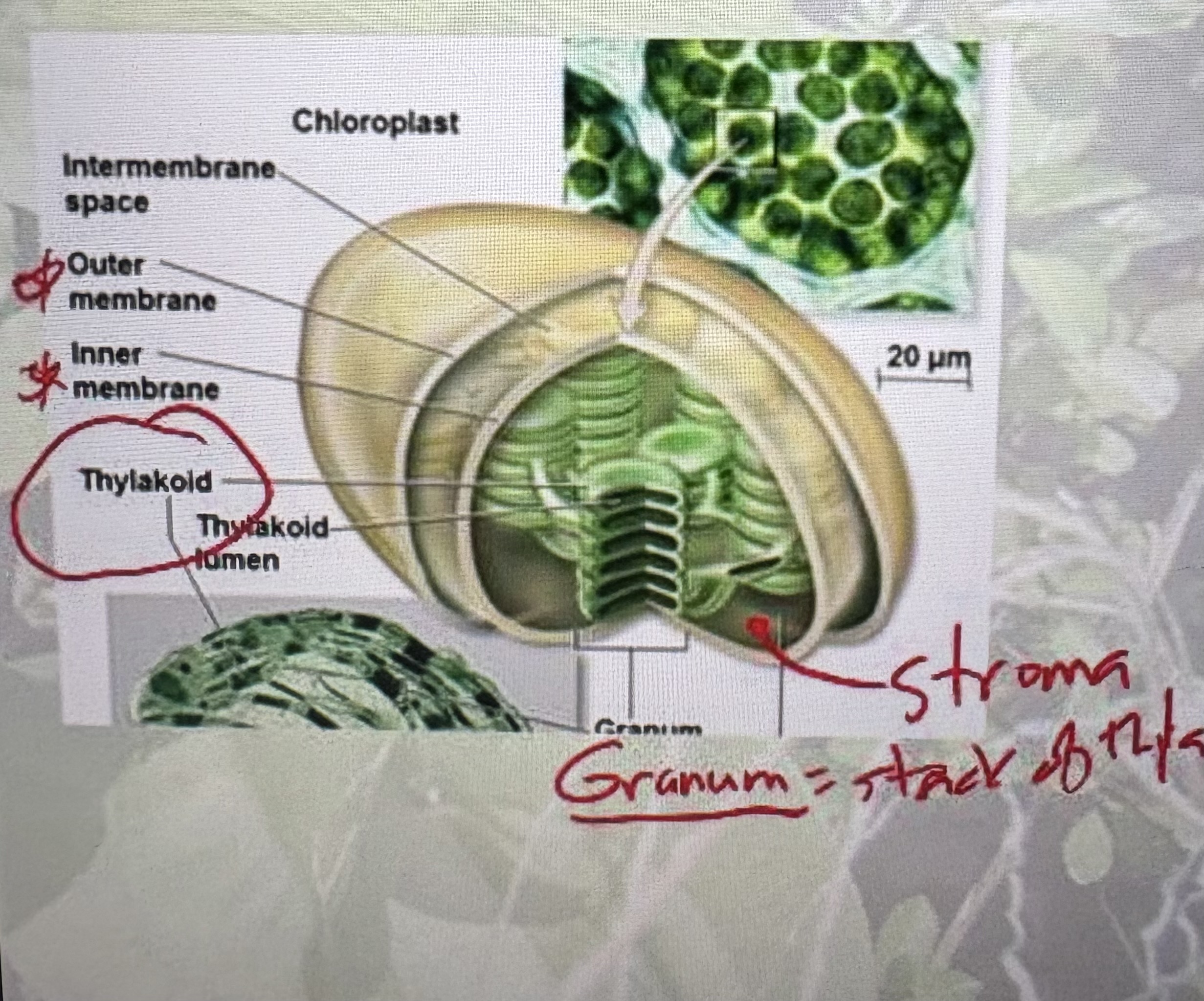
The 2 stages of Photosynthesis
Light reactions
-light dependent rxns
-photosystem 2
-photosystem 1
Dark Reactions
-light independent rxns
-Calvin cycle
Light Reactions: Location and what is produces
-occurs in the thylakoid membrane
-produces ATP, NADH and oxygen
Light Reactions: steps
photosystem 2 and 1 (proteins in thylakoid membrane)
Light energy absorbed by pigments (chl. A, chlorophylls and others)
Light is captured and its energy is converted into charged electrons. (from H2O split)
Electron passed down chain, energy (ATP) emitted, used to create products.
Dark Reactions: location and what is produces
-occurs in the stroma
-uses ATP, NADH, and CO2 to produce sugars
-follows light rxns
-light independent
Dark Reactions: The Calvin Cycle
produced: sugars (glucose: C6H12O6)
Carbon dioxide
ATP from Light Reactions
NADPH from light reactions
sugar produced
need to use most of produced sugar plus some more ATP to restart the cycle.
Visible Light Spectrum
“white light” range are wavelengths that get absorbed.
Pigment Absorption Spectrum
-different pigments absorb different wavelengths, so more energy is absorbed
-other pigments transfer energy to Chl. A
Photosynthesis takes _______ to make sugars (carbs).
water light and carbon dioxide.
(oxygen is a by-product)
Photosynthesis RECAP
light reactions:
-capture sunlight energy
-produce ATP
-produce electron carriers: batteries (NADPH)
-sugars (carbs) store energy)
dark reactions:
-calvin cycle
-takes carbon dioxide and uses ATP and energy store in electron carriers from light rxns to create sugars.
The sugars in photosynthesis that are stored and where they are stored
Glucose:
-produced by photosynthesis
Glycogen:
-stored in carbs of animals
Cellulose:
-cell walls (most abundant carb)
Starch:
-stored carb in plants
Overview of Plant Transport
-root system absorbs water and dissolved minerals from the soil
-shoot system takes up CO2 from the atmosphere via stomata (leaf openings)
*-photosynthetic mesophyll cells use these material to produce organic compounds (carbs) needed from growth and reproduction.
-long-distance transport occurs within the plant body using continuous system of conducting tissues.
Xylem and Phloem transport in plants
Xylem: transport water and dissolved minerals
-unidirectional (just up or just down)
Phloem: transports organic substances in a watery sap
-bidirectional (up and down)
Importance of Water
-photosynthesis
-support for plant organs (most chemical reactions)
-conduction
-cell elongation
-average plant cell: 90% water
-solvent for most substances: solution, solvent, solute.
Properties of Water
-polar molecule: neutral
-hydrogen bonding
-cohesiveness
-adhesiveness (ex: cellulose)
-temperature stabilization
-transport medium
-best biological solvent
-occurs in all 3 forms within earth’s temp. range (solid, liquid, gas)
Principles of Movement
-purely physical processes
-no ATP expenditure
-bulk or mass flow
-diffusion (simple and facilitated)
-osmosis
bulk or mass flow movement
-mass movement of liquid caused by pressure, gravity, or both.
-ex: movement of ions through soil to plant rods.
-movement faster than by diffusion.
Simple Diffusion
movement of molecules through a phospholipid bilayer down a concentration gradient.
-high to low
Facilitated Diffusion
transport of molecules across the plasma membranes down a concentration gradient with the aid of membrane transport proteins.
Osmosis
-diffusion of water across a selectively permeable membrane in response to differences in solute concentrations.
-simple diffusion doesn’t occur fast enough for rapidly expanding plant cells, so osmosis is used.
Aquaporins!
Aquaporins
protein channels that allow facilitated diffusion of water.
plasma membrane is the
gatekeeper of the cell
Solute vs water movement in osmosis
high to low
-high solute and low water: water comes into cell and solute leaves cell
-high water and low solute: water leaves the leave and solute comes into cell.
Cellular Water Content
water content of plant cells depends on osmosis which depends on:
-solute concentration
-turgor pressure: hydrostatic pressure that increases as water enters plant cells. (cell walls restricts the extent to which cells can swell)
Turgid plant cells
has a cytosol full of water and plasma membrane that pushes up against cell wall.
Plasmolyzed cell
has lost so much water that the turgor pressure is lost and the plasma membrane no longer presses on the cell wall.
Water Potential
-potential energy of water
-water moves from higher to lower water potential/gravity/concentration. (this is affected by pressure, solutes and other factors)
-concept used 2 ways!
2 ways water potential is used
to understand the movement of water into and out of cells. (cellular water potential)
to understand the movement of water between entire plants and their environment.
Water and Soil Minerals Movement through the plant
-Transpiration: evaporation of water from plant surfaces to due heat of sunlight energy; “cost” for the plant to live on land.
-Transpiration is the primary form of long distance water transport in plants.
-plants expend no energy on bulk flow.
Leaf Anatomy
-Wax cuticle: covers epidermis and keeps water in
-circles in the middles are Xylem and Phloem. X on top and P on bottom.
-CO2 goes into the stomas and H2O vapor leaves through the stomas.
-guard cells surround the stomas (enters/exit of the leaf)
-mesophyll: main part of the inner part of the leaf.
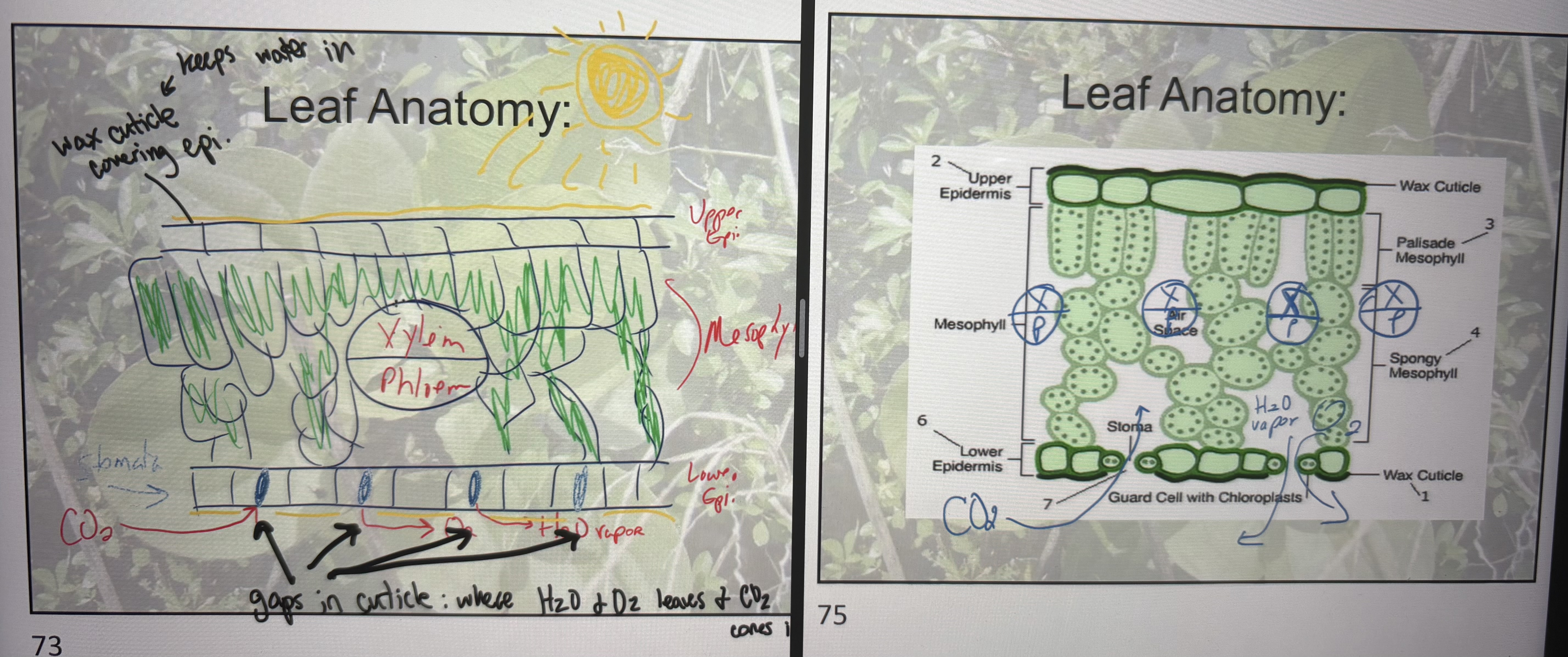
Stomata
-plants produce a waxy cuticle to prevent water loss, but not over the stomata.
-the stomata facilitates gas exchange.
-around 90% of water that evaporates from plants is lost through stomata as vapor.
-when stomata’s are open, O2 and water vapor are released and CO2 is taken up.
Xylem’s specialized cells
-flowering plant xylem contains several types of specialized cells:
Parenchyma cells are alive.
Thick-walled supportive fibers may be alive or dead at maturity.
and 4. Tracheid and Vessel members(only angiosperms) are specialized water-conducting cells are always dead and empty of cytosol when mature.
Mechanism for Guard Cells
-daytime/sunlight: CO2 is low in leaf
-guard cells pump in K (ATP): changes solute concentration.
-H2O from xylem moves by osmosis into guard cells (turgid)
-Guard cells swell and open stoma.
-Pump out K (ATP), H2O moves by osmosis out of guard cells causing shrinking.
Cause of Water Loss
-Sunlight energy: heats up leaf causing evaporation of H2O from mesophyll cells.
-causes a decrease in H2O concentration, causing a pull of H2O and soil nutrients.
-this pull moves H2O through the xylem tissue that forms a pipe.
C-A-T Mechanism
-once stomata open, purely physical process- unidirectional.
-pull of H2O one molecule at a time due to H-bonding.
Cohesion: H2O molecules stick together.
Adhesion: H2O adheres to cellulose in walls.
Tension: pull due to H2O loss from mesophyll.
Solute Movement in Plants
-Translocation: movement of solutes in plants.
-Food: dissolved in H2O; moved in the form of sucrose (double sugar)
Similarities between translocation and transpiration
BOTH: involve conduction and involve physical properties of H2O.
Differences between translocation and transpiration
Translocation:
-phloem
-bidirectional (up and down)
-must expend ATP energy by plant.
Transpiration:
-xylem
-unidirectional (up or down)
-sunlight energy (no expenditure by plant)
Long-Distance Transport in Phloem
-phloem transports sugars from where they are produced and/or stored (source) to other sites where they are used or needed (sink).
-Primary and secondary phloem
Primary Phloem
occurs in the vascular bundles of herbaceous plants.
Secondary Phloem
occurs as inner bark of woody plants.
Phloem Structure
phloem of flowering plants is composed of:
fibers
parenchyma cells
sieve-tube members
companion cells
-sieve tube members (STM) are stacked end-to-end, and together with companion cells, form a system to transport soluble organic substances.
sieve tube members (STM)
-sieve tube members (STM) are stacked end-to-end, and together with companion cells, form a system to transport soluble organic substances.
-sieve-tube members loses its nucleus and most of the cytoplasm to reduce obstruction to bulk flow.
-phloem sap passes through sieve plate pores.
Pressure Flow Hypothesis: At source
companion cells ‘pump’ sucrose into STMs (ATP expenditure)
as sucrose concentration increases in STMs, water potential.
(concentration) decreases within STMs.
adjacent xylem has higher water potential than STMs; H2O moves STMs by osmosis.
Pressure Flow Hypothesis: at sink
companion cells unload sucrose (ATP expenditure)
sucrose converted to starch for storage in root cortex.
with out sucrose, high H2O potential in STM.
H2O moves from STM to adjacent xylem by osmosis
Pressure Flow Hypothesis: Source and Sink continued
-ATP spent only by companion cells at source (loading) and sink (unloading).
-BULK FLOW of sucrose (higher pressure to lower pressure.
-Bulk flow (pressure/potential differences) and osmosis (H2O potential/concentration differences) → NO energy expenditure.